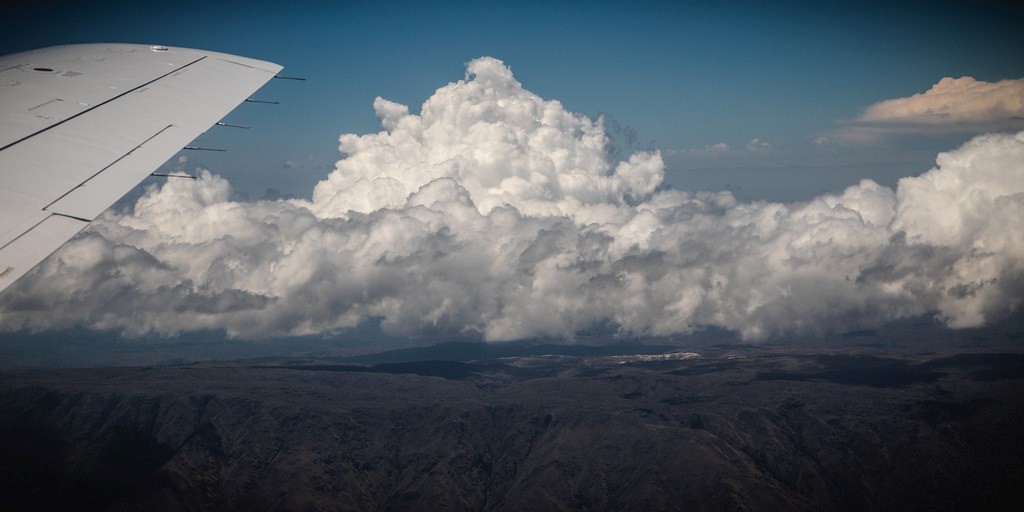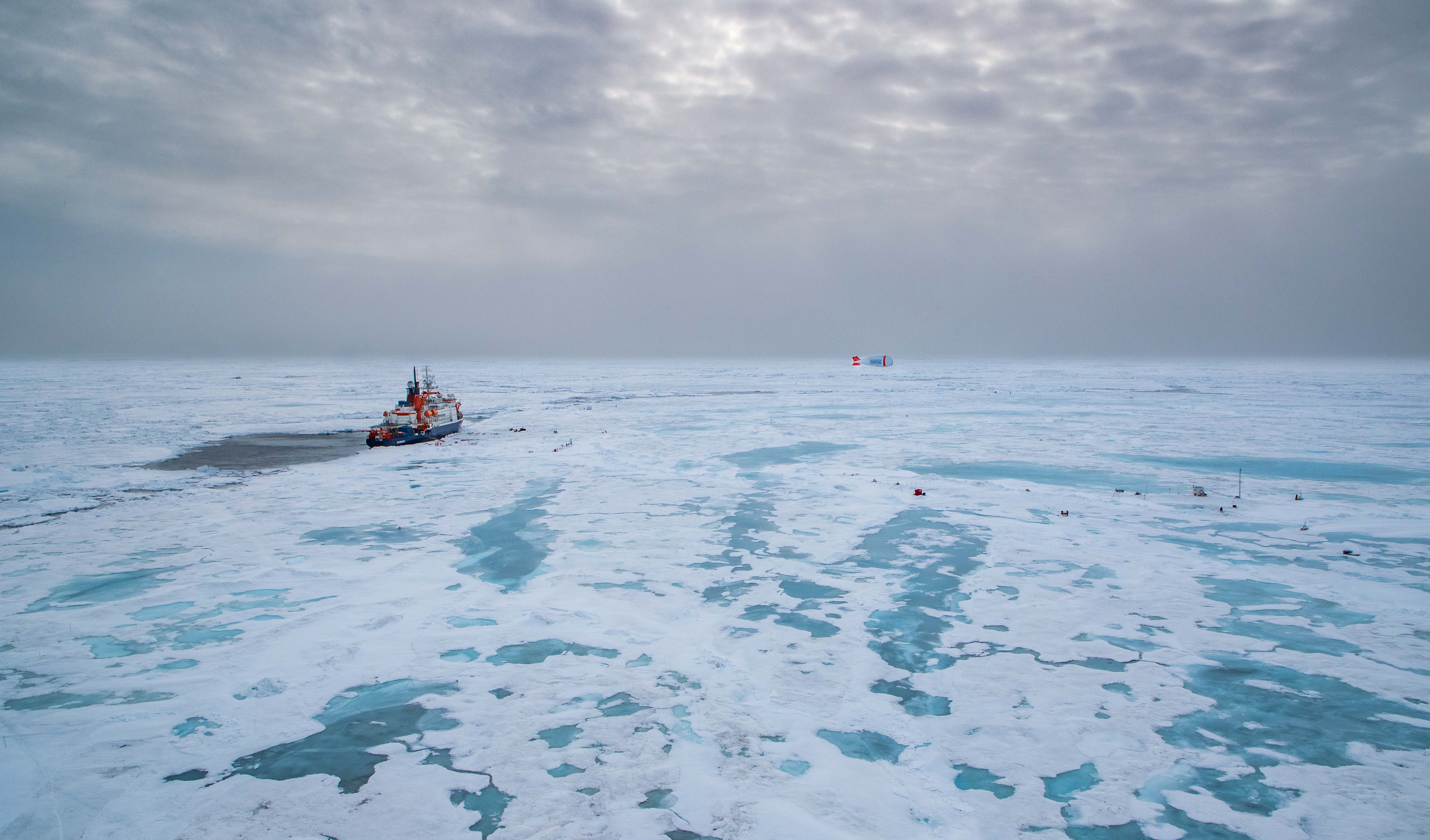2021 AMS Presentations Featuring ARM Data
Published: 19 January 2021
Editor’s note: Attendees of the virtual 2021 American Meteorological Society (AMS) Annual Meeting can log in to the meeting platform to view posters, presentations, and recordings until April 15.
 With the 2021 American Meteorological Society (AMS) Annual Meeting going virtual, we want to make it easy for you to find ARM-relevant science during the meeting.
With the 2021 American Meteorological Society (AMS) Annual Meeting going virtual, we want to make it easy for you to find ARM-relevant science during the meeting.
Below is a list of ARM-related AMS meeting highlights (all times Eastern; AMS login might be required to view abstract pages). Follow us on Twitter (@armnewsteam) and Facebook (@arm.gov) for a real-time guide to relevant activities using the hashtag #ARMAMS.
Go here to find more ARM-related presentations and posters, as well as sessions, talks, and posters related to Atmospheric System Research (ASR).
Add your presentation here to be featured on the ARM or ASR presentation web pages.
ARM is also hosting a virtual AMS booth, where you will be able to chat with ARM Technical Director Jim Mather and featured guests during the week of January 11–15 at 11:30 a.m. Eastern each day. After you log in to the AMS virtual meeting platform, you can find the ARM booth by clicking to enter the Exhibit Hall and searching for “Atmospheric Radiation Measurement (ARM) User Facility.”
Click Below to View:
Town Halls
ARM-Related Town Halls
- 11.III – Science and Deployment Plan for the DOE Third Atmospheric Radiation Measurement Mobile Facility: Coupled Observational-Modeling Studies of Land-Aerosol-Cloud Interactions in the Southeastern United States
Thursday, January 14, 1–2 p.m.
Co-Chairs: Shawn Serbin and Scott Giangrande, Brookhaven National Laboratory
Organizer and Facilitator: Chongai Kuang, Brookhaven National Laboratory
- 12.III – Case Libraries of Shallow and Deep Convection Large-Eddy Simulations from the U.S. DOE Atmospheric Radiation Measurement Facility’s LASSO Activity
Thursday, January 14, 4–5 p.m.
Co-Chairs: William I. Gustafson, Pacific Northwest National Laboratory; Andrew Vogelmann, Brookhaven National Laboratory
Organizers: William I. Gustafson and James H. Mather, Pacific Northwest National Laboratory; Andrew Vogelmann, Brookhaven National Laboratory
Other DOE Earth and Environmental Systems Sciences Division Town Halls
- 4.II – DOE’s Integrated Human-Earth Systems Modeling: Five New Efforts, Opportunities, and Stakeholder Engagements
Tuesday, January 12, 10:30–11:30 a.m.
Co-Chairs: Gerald Geernaert and Robert Vallario, DOE
Organizer: Robert Vallario, DOE
Panelists: Robert Vallario, Gerald Geernaert, and Renu Joseph, DOE; David Lesmes, U.S. Geological Survey; Ian Kraucunas and Katherine Calvin, Pacific Northwest National Laboratory; Andrew Jones, Lawrence Berkeley National Laboratory
Related Interagency Town Halls
- 12.II – The Interagency Council on Advancing Meteorological Services (ICAMS): A New Approach to Federal Meteorological Coordination and Innovation
Thursday, January 14, 4–5 p.m.
Co-Chairs: Antonio Busalacchi, University Corporation for Atmospheric Research; Jenni Evans, Pennsylvania State University
Organizers: Alexandra M. Keclik, National Weather Service; Katherine Brogan and Kim Doster, NOAA
Panelists: James Irons, NASA; Andrew Stern, NOAA; Amy Mahn, NIST; Gerald Geernaert, DOE
Keynotes and Invited Oral Presentations
Please note: Most presentations are scheduled to run for five minutes, so the full session times are listed below for planning purposes.
- 1B.5 – Ecosystem on Fire: How Do Smoke Emissions Relate to Heat Produced From Large Wildfires? (Invited). Rainer Volkamer, University of Colorado, Boulder.
Monday, January 11, 10–11 a.m.
- 1.4 – Dynamically Evolving Absorption of Biomass Burning Aerosols and Impact on Radiation (Invited). Yan Feng, Argonne National Laboratory.
Monday, January 11, 10–11 a.m.
- 2.1 – Aerosol-Cloud-Climate Interactions in Warm Clouds: Recent Results and Future Directions (Core Science Keynote). Robert Wood, University of Washington.
Monday, January 11, 1–2 p.m. (Wood’s talk is scheduled from 1:10–1:25 p.m.)
- 4.5 – Aerosol-Cloud Interactions Within the Context of the Larger-Scale Circulation Over the Subtropical Southern Oceans in Observations and Models (Invited). Paquita Zuidema, University of Miami.
Tuesday, January 12, 10:30–11:30 a.m.
- 5.3 – Aerosol Properties and Processes in the Eastern North Atlantic (Invited). Jian Wang, Washington University in St. Louis.
Tuesday, January 12, 1–2 p.m.
- 5.4 – Seasonal Contrasts in Cloud-Aerosol Interactions Over the Eastern North Atlantic (Invited). Robert Wood, University of Washington.
Tuesday, January 12, 1–2 p.m.
- 6B.6 – Arctic Aerosol Composition Influenced by the North Slope of Alaska Oil Fields (Invited). Kerri A. Pratt, University of Michigan.
Tuesday, January 12, 4–5 p.m.
- 6.1 – Potential Impact of Aerosol on Precipitation, Severe Weather, and Lightning (Invited). Zhanqing Li, University of Maryland, College Park.
Tuesday, January 12, 4–5 p.m.
- 9.1 – On Precipitation From Polar Mixed-Phase Clouds (Invited). Ann Fridlind, NASA Goddard Institute for Space Studies.
Wednesday, January 13, 3:30–4:30 p.m.
- 14B.i.1 – Exploring Environmental Influences on Surface DSDs (Invited/Keynote). Brenda Dolan, Colorado State University.
Friday, January 15, 1–1:40 p.m. (Dolan’s talk is scheduled from 1:10–1:25 p.m.)
- 14.2 – New Insights Into the Growth of Pollution Nanoparticles via SOA Formation and Their Impacts on Clouds (Invited). Rahul A. Zaveri, Pacific Northwest National Laboratory.
Friday, January 15, 1–2 p.m.
- 14.8 – New Particle Formation Over the Oceans: Results From Recent Field Campaigns (Invited). Jian Wang, Washington University in St. Louis.
Friday, January 15, 1–2 p.m.
Featured Field Campaigns and Topical Sessions
Aerosol and Cloud Experiments in the Eastern North Atlantic (ACE-ENA)

For a better understanding of aerosols and low clouds in the remote marine environment, ACE-ENA used measurements from ARM’s Eastern North Atlantic observatory in the Azores and data from ARM’s now-retired Gulfstream-159 (G-1) research aircraft. The campaign took place during two intensive operational periods in summer 2017 and winter 2018.
ACE-ENA data are helping researchers learn more about topics such as the budget of cloud condensation nuclei in the marine boundary layer, cloud and drizzle microphysics, and the effects of aerosols on marine low clouds and precipitation in the region.
Please note: Most presentations are scheduled to run for five minutes, so the full session times are listed below for planning purposes.
ORAL SESSION—Aerosol-Cloud Interactions in Warm Clouds; Aerosol, Clouds, and Precipitation, and Their Interactions During DOE ACE-ENA IOPs
Tuesday, January 12, 1–2 p.m. (Session 5 during the 13th Symposium on Aerosol-Cloud-Climate Interactions)
Co-Chairs: Xiquan Dong, University of Arizona; Zhaoyi Shen, California Institute of Technology; Youtong Zheng, University of Maryland, College Park
Reported ARM Presentations:
- 5.3 – Aerosol Properties and Processes in the Eastern North Atlantic (Invited). Jian Wang, Washington University in St. Louis.
- 5.4 – Seasonal Contrasts in Cloud-Aerosol Interactions Over the Eastern North Atlantic (Invited). Robert Wood, University of Washington.
- 5.7 – Vertical Dependence of Horizontal Variation of Cloud Microphysics: Observations From the ACE-ENA Field Campaign and Implications for Warm Rain Simulation in Climate Models. Zhibo Zhang, University of Maryland, Baltimore County.
- 5.8 – Evaluating Cloud Droplet Number Concentration Retrievals in Marine Stratocumulus With ACE-ENA Measurements. Damao Zhang, Pacific Northwest National Laboratory.
- 5.9 – Investigation Into the Effect of Turbulence on Warm Rain Initiation Using Digital Holography. Neel Desai, Brookhaven National Laboratory.
- 5.10 – Effect of Wind Shear on Entrainment Mixing in Marine Stratocumulus Clouds Measured During the ACORES/ACE-ENA Projects. Jaemin Yeom, Michigan Technological University.
POSTER—665 – Vertical Variation of Entrainment-Mixing Mechanisms in Stratocumulus Clouds. Sinan Gao, Nanjing University of Information Science and Technology.
Wednesday, January 13, 2–3:30 p.m.
POSTER—676 – Chemical Composition and Ice Nucleation of Ambient Aerosol From Ground and Airborne Measurements Over the Eastern North Atlantic. Peiwen Wang, Stony Brook University.
Wednesday, January 13, 2–3:30 p.m.
Cloud, Aerosol, and Complex Terrain Interactions (CACTI)

From October 2018 through April 2019, CACTI collected ground and aerial data to explore the life cycles of convective clouds in Argentina’s Sierras de Córdoba mountain range. This area is said to spawn the biggest thunderstorms in the world. The campaign featured the first deployment of the second-generation C-Band Scanning ARM Precipitation Radar, which delivers slice-like flat images of the atmosphere. CACTI ran concurrently with Remote sensing of Electrification, Lightning, And Mesoscale/microscale Processes with Adaptive Ground Observations (RELAMPAGO), a campaign funded largely by the National Science Foundation.
With 80 days of deep convection observed, CACTI represents a new wealth of measurements on cloud dynamics and microphysics, ambient thermodynamic and kinematic and surface conditions, and properties of aerosols. The next scenario of focus for the Large-Eddy Simulation (LES) ARM Symbiotic Simulation and Observation (LASSO) activity will be deep convection during CACTI.
Please note: Most presentations are scheduled to run for five minutes, so the full session times are listed below for planning purposes.
ORAL SESSION—Mesoscale Symposium: Mesoscale–Microscale Interactions
Monday, January 11, 1–2 p.m. (Session 2 during Mesoscale Processes Across Scales: Engaging With Communities in the Physical and Social Sciences)
Co-Chairs: Stephen W. Nesbitt, University of Illinois at Urbana-Champaign; Daniel J. Kirshbaum, McGill University
CACTI Session Presentations:
- 2.4 – Perspectives on Deep Convective Updraft Modes Using Multisensor Remote Sensing Data From RELAMPAGO-CACTI. Stephen W. Nesbitt, University of Illinois at Urbana-Champaign.
- 2.5 – Dual-Doppler Observations of Deep Convection Initiating in Complex Terrain During RELAMPAGO-CACTI. James Marquis, Pacific Northwest National Laboratory.
- 2.6 – Characteristics of Convective Initiation and Upscale Growth Observed in the Complex Terrain of Central Argentina. Zhe Feng, Pacific Northwest National Laboratory.
- 2.7 – Analysis of Observed Near-Cloud Environments Supporting Convective Initiation During RELAMPAGO-CACTI and Their Impacts Within Idealized Cloud-Scale Simulations. Timothy Connor Nelson, University of Colorado, Boulder.
POSTER—323 – Evaluation of Aerosol Indirect Effects on Deep Convective Clouds During CACTI. Peter G. Veals, University of Utah.
Monday, January 11, 2–3:30 p.m.
POSTER—333 – Evaluation of Simulated Atmospheric and Cloud Microphysical Effects on Deep Convective Upscale Growth. Zhixiao Zhang, University of Utah.
Monday, January 11, 2–3:30 p.m.
ORAL PRESENTATION—10.6 – Ice-Nucleating Particles in Midlatitude Continental Regions of North America, South America, and Europe. Paul J. DeMott, Colorado State University.
Thursday, January 14, 10:30–11:30 a.m.
Measurements and Modeling of Cloud Condensation Nuclei and Ice-Nucleating Particles

Concentrations of cloud condensation nuclei (CCN), particles on which water vapor can condense to form cloud droplets or ice particles, deeply influence aerosol-cloud interactions and subsequent earth system effects. Ice-nucleating particles (INPs) can originate from sea spray, soot from biomass burning, bacteria, fungi, or carbon-rich organic dust generated during tilling and harvesting agricultural land.
Measurements of INPs and CCN are sparse, contributing to large uncertainties in models of global earth system change. Two sessions at AMS will focus on measurements and modeling of INPs and CCN.
Please note: Most presentations are scheduled to run for five minutes, so the full session times are listed below for planning purposes.
ORAL SESSION—Measurements and Modeling of CCN and INP. Part I
Thursday, January 14, 10:30–11:30 a.m. (Session 10 during the 13th Symposium on Aerosol-Cloud-Climate Interactions)
Co-Chairs: Ottmar Moehler, Karlsruhe Institute of Technology; Naruki Hiranuma, West Texas A&M University; Isabelle Steinke, Pacific Northwest National Laboratory
Reported ARM Presentations:
- 10.4 – Investigation of Proxy Measurements for the Estimation of Aerosol Properties Relevant to CCN and INP Over the Southern Ocean. Sonia M. Kreidenweis, Colorado State University.
- 10.6 – Ice-Nucleating Particles in Midlatitude Continental Regions of North America, South America, and Europe. Paul J. DeMott, Colorado State University.
- 10.8 – Relative Importance of High-Latitude Local and Long-Range Transported Dust to Arctic INPs and Impacts on Mixed-Phase Clouds. Yang Shi, Texas A&M University.
- 10.9 – Highlighting Gaps in Understanding the Emission of Warm-Temperature INPs in Marine Environments. Isabelle Steinke, Pacific Northwest National Laboratory.
- 10.10 – A Field-Observational Approach to Aerosol-Ice Formation Closure. Daniel A. Knopf, Stony Brook University.
ORAL SESSION—Measurements and Modeling of CCN and INP. Part II; Advances in Observational and Modeling Studies of the Role of Mineral Dust in the Earth System
Thursday, January 14, 1–2 p.m. (Session 11 during the 13th Symposium on Aerosol-Cloud-Climate Interactions)
Co-Chairs: Hongbin Yu, NASA Goddard Space Flight Center; Bing Pu, University of Kansas; Isabelle Steinke, Pacific Northwest National Laboratory
Reported ARM Presentation:
Keep up with the Atmospheric Observer
Updates on ARM news, events, and opportunities delivered to your inbox
ARM User Profile
ARM welcomes users from all institutions and nations. A free ARM user account is needed to access ARM data.


















